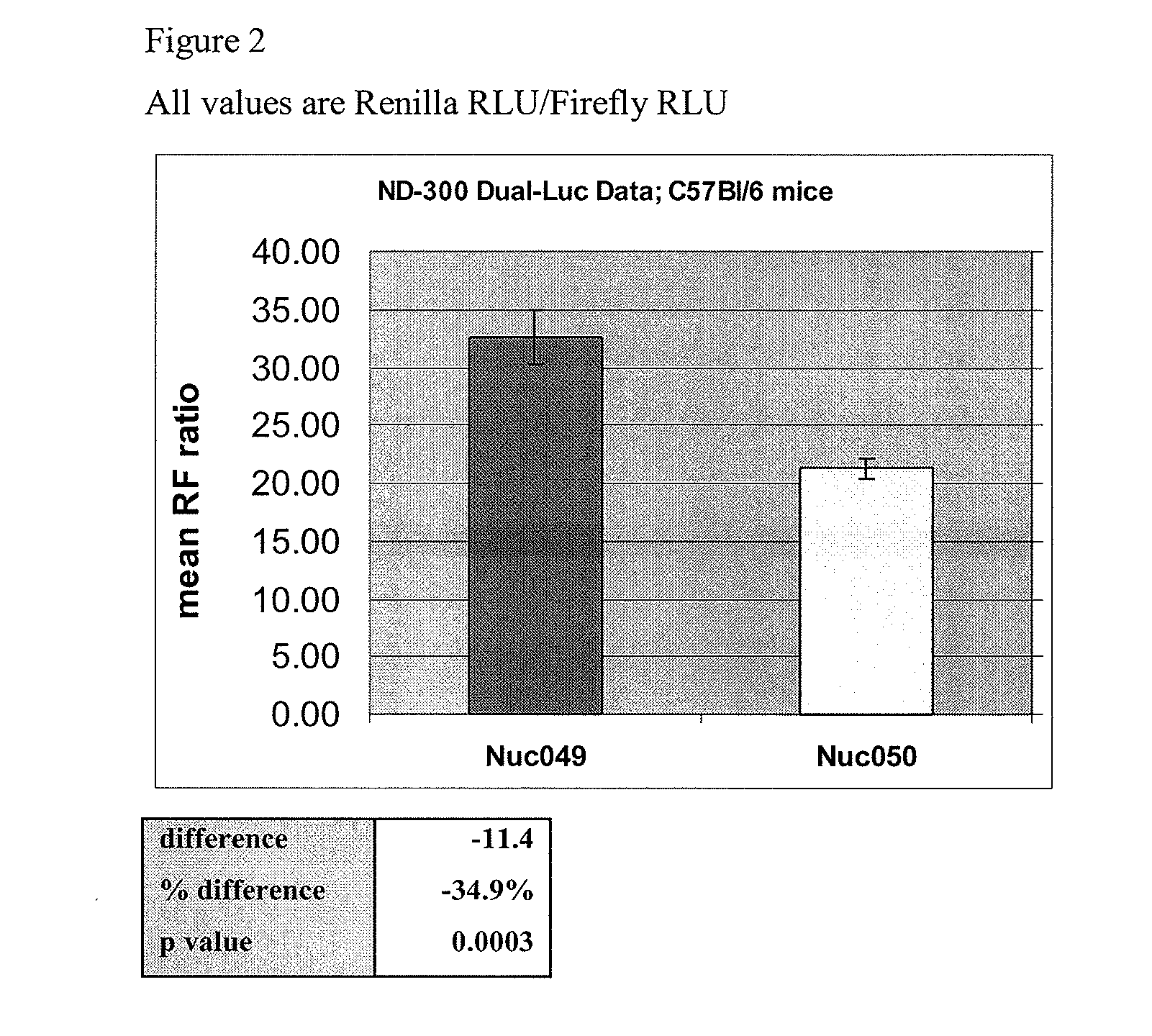In Vivo Delivery Of Double Stranded RNA To a Target Cell
- Summary
- Abstract
- Description
- Claims
- Application Information
AI Technical Summary
Benefits of technology
Problems solved by technology
Method used
Image
Examples
example 1
Therapeutic Inhibition of HBV sAg Gene Expression In Vivo by Intramuscular Injection
[0090]In the therapeutic model, animals receive exogenous RNA target in the form of a plasmid expressing the surface antigen coding sequence of HBV via hydrodynamic tail vein injection. Hydrodynamic injection is a method using a large volume with rapid injection time, to preferentially direct the DNA plasmid to the liver where it is expressed.
[0091]To obtain mice expressing a target gene in liver, HBsAg (surface antigen) cDNA was placed under the control of a liver-specific promoter in a commercially available plasmid vector (pLIVE). On Day −10, this vector was injected hydrodynamically into an immunodeficient strain of mice (NOD.CB17-Pkrdcscid / J). In this way, DNA is largely localized to liver hepatocytes and the tissue-specific promoter further restricts expression of the sAg mRNA to these cells. Since the mice are immunodeficient, they are able to express the target gene for long periods of time (...
example 2
Therapeutic Inhibition of HBV sAg Gene Expression In Vivo by Intramuscular Injection
[0096]Mice (immunodeficient strain NOD.CB17-Pkrdcscid / J) were given target HBV sAg (surface antigen) expression plasmid (directed to liver by hydrodynamic injection as described in Example 1) several days before being injected IM (intramuscularly) with 1) eiRNA vector expressing anti HBV shRNA, 2) negative control vector, or 3) left untreated after the initial injection of target plasmid. The eiRNA vectors for IM injection were formulated with 0.25% bupivacaine. Expression levels of the sAg, produced in the liver, were monitored by sAg ELISA of serum samples over the course of about 4 weeks.
[0097]In this model, sAg expression is expressed at a given level following injection, and then declines gradually over several weeks, if left simply to its own course, as seen in the mice left untreated after the initial target plasmid injection. By administering the eiRNA anti-sAg shRNA plasmid, the rate of decl...
example 3
Prophylactic Inhibition of HBV sAg Gene Expression In Vivo by Intramuscular Injection
[0098]Mice (immunocompetent strain C57Bl / 6) were given a single intramuscular dose of the anti HBV shRNA effector plasmid, NUC050, or a negative control plasmid, which was followed three days later by hydrodynamic injection (via tail vein) of the target HBsAg plasmid (same target plasmid as in Exp 1 above). The control plasmid used in this experiment was the commercial vector pGL2, which encodes no protein and is used as an irrelevant plasmid control with respect to eiRNA activity. The IM injections were formulated with bupivacaine (0.25% w / v) with a DNA concentration of 1.0 mg / ml. 100 ul of the bupivacaine foimulation was administered IM to each mouse (100 ug DNA).
[0099]Mice were bled for HBsAg ELISA assay at 3, 6, 9, and 13 days after the hydrodynamic administration of target plasmid.
[0100]Since the target plasmid encoding HBsAg mRNA and protein is given subsequent to the effector plasmid in the p...
PUM
| Property | Measurement | Unit |
|---|---|---|
| Time | aaaaa | aaaaa |
| Surface | aaaaa | aaaaa |
Abstract
Description
Claims
Application Information
 Login to View More
Login to View More - R&D
- Intellectual Property
- Life Sciences
- Materials
- Tech Scout
- Unparalleled Data Quality
- Higher Quality Content
- 60% Fewer Hallucinations
Browse by: Latest US Patents, China's latest patents, Technical Efficacy Thesaurus, Application Domain, Technology Topic, Popular Technical Reports.
© 2025 PatSnap. All rights reserved.Legal|Privacy policy|Modern Slavery Act Transparency Statement|Sitemap|About US| Contact US: help@patsnap.com



